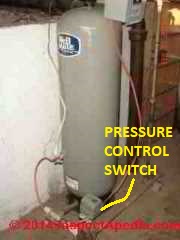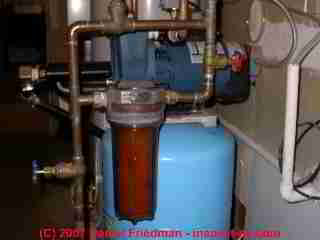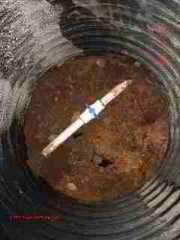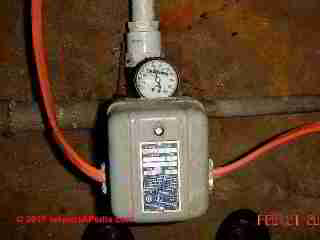 How Well Pipe Leaks Cause Pump Short Cycling
How Well Pipe Leaks Cause Pump Short Cycling
- POST a QUESTION or COMMENT about well pipe leaks causing intermittent well pump cycling on and off.
How to diganose & fix a well pump that turns on and off too frequently - short cycling well pumps. This article explains how a water pump cycling on and off problem was traced to leaks in the well piping, and how those leaks were found and repaired.
InspectAPedia tolerates no conflicts of interest. We have no relationship with advertisers, products, or services discussed at this website.
- Daniel Friedman, Publisher/Editor/Author - See WHO ARE WE?
How do I Diagnose & Fix a Short Cycling Well Pump due to Well Piping Leaks?
 Reader Question: My well pump is short cycling on and off but pressure in the building holds steady. I think I have a well pipe leak
Reader Question: My well pump is short cycling on and off but pressure in the building holds steady. I think I have a well pipe leak
I have been trouble shooting a problem with my well in my 100+ year old home over the last week and ... am asking for help in diagnosing the cause of short cycling of my water pump.
I first noticed short cycling of the pump (could hear the water hammer as pump shut off when in my well house which is also my shop) - The well would pump up to 68 psi and shut-off, then the pressure would rapidly drop to 38 and restart. I could hear water moving in the lines, but no faucets were on.
I then shut the valve upstream from the pressure tank (between the well, but before the gauge) and the pressure would hold steady (the house and all lines stayed pressurized until a faucet was opened).
I figured the check valve must be out if it drained so rapidly, and I replaced the check valve, but the same problem was occurring.
So I noticed my pressure tank was pretty water logged and I drained off water, added back air to 38 psi, and turned back on the water supply.
That did significantly slow the cycling (from about every 15 seconds to now over a minute), but the pressure still drops when the pump clicks off. I am not having any problem with water pressure in the house lines (faucets/shower/etc).
[Our photo (left) shows a commercial type Square D 9013 Pumptrol pressure control switch. Courtesy of reader J.H.]
I am not getting any air out of any lines. I believe my well pump is working well, the pressure tank seems to be working well (with the addition of the air), I assume the foot valve is ok since I am not losing prime/pressure and I am not getting air.
I think I am dealing with a broken line/fitting underground between well/check valve and the house/pressure tank.
I have not seen any wet spots in the yard and I have been running pump all week (continues to cycle on-off about every 90 seconds). Any other ideas? Any recommendations on finding leak underground or just start digging. -- J.H.
Reply: Diagnostic Tips that May Trace Down Short Pump Cycling to a Piping Leak
We are GUESSING from your description several things to check out or satisfy ourselves about, and I ask a few questions for clarification:
[Photo at left shows a Wellxtrol auxiliary water pressure tank. In this location a small pressure tank may also serve to reduce water hammer. The main water pressure tank for this system is shown at the top of This article .]]
- It sounds as if you might have a leak
(as you suggest) in the well line between foot valve (or submersible pump in the well?) and the house, possibly compounded by a waterlogged pressure tank (that you addressed). A leak will cause lost prime, can force air into plumbing lines, and can cause a water hammer sound when the pump comes on in some cases.- That rapid pressure drop
after the pump shuts off is suggestive of a well line leak- We agree that shutting a valve between well and house piping
and seeing that house pressure remained steady is a good indicator that the leak is upstream (towards the well) from that point. I infer that opening that valve and then opening a faucet in the house was allowing backflow of water and perhaps even air into the leaky line- The behavior suggests that water is falling back down the well line
so your leak could be actually in the vertical piping inside the well casing.- Is your pump a submersible
one in the well?If so that would be why you don't lose prime - the pump is self-priming in that location.
And even if that pump's internal check valve is ok, a leak above the pump (towards the house) would still leak - either back into the well or into the ground - when the pump shuts off. And when the pump is on, in addition to sending water to the house it's spraying water out of the same leak opening.- b is puzzling but perhaps if air is entering the leaky line and is later forced up towards the house it's so far a small volume and is trapped in the pressure tank - I've seen systems designed to actually work this way, forcing air back and forth to avoid freezing water lines that extended out into and deep down into a lake.
- You wouldn't see wet spots in the yard
if the well line leak is in the well casing or if the leak history has blown a cavity in the soil around the buried well line or if the line is deep enough, or if the line depth plus leak history have given an entirely-below-ground escape path for water forced out of the line when the pump is on.
But you might see soil in your water - sucked into a leaky well line if the line leak point is in soil rather than in the well casing.- There could also be a leak at the pitless adapter
- We think your next step is to pull the well line up
and inspect it from within the casing - doubtless needing the help of a well plumber experienced with that step - don't lose anything down in the well.Watch out: before you go to the trouble and expense of replacing a water pressure tank, make sure that you have correctly diagnosed the problem that you are "curing" - you wouldn't want to replace a water tank only to find that you still have the water pressure or quantity problem because another, perhaps less costly, part was at fault.
Next Steps in Well Pump Short Cycling Diagnosis and Repair - Well Piping Leaks
 Yes I have a submersible pump and what you say about air and prime makes perfect sense.
I am going to start digging the well line near the well this weekend. I will take some pictures and keep you posted.
Yes I have a submersible pump and what you say about air and prime makes perfect sense.
I am going to start digging the well line near the well this weekend. I will take some pictures and keep you posted.
... snow finally melted here and I started digging up the yard....
- I found the well line at near 38 inches deep, plastic water piping with 20 ft sections.
- I already found one small well piping leak at a joint (not big) kept going, ended up uncovering nearly 250 ft of line and finally found the branch that goes out to my pool (another leak, but not huge).
- So, I put in a shut off valve in that branch and turned on the system and was holding pressure and no cycling. [Photo at left]
- So I fixed two small leaks, but I still have a big one out on pool line but now my house is up and running and no extra wear on my pump.
- I was going to dig more this weekend but my back is not ready for the job yet! I will keep you posted and I have a guess that it is where there is a brass stop and waste that is hooked to the plastic pvc that is used to turn off the pool water in fall. It is in a very tough place to dig up, but I am guessing that is my trouble. Wish I would have started there!
But at least I got other leaks fixed and have another shut off valve in a water main that I can get my shoulders down in. Will let you know what I find when I take on the next task.
I will try and get more when I find the big leak.
Definitions of Well Pump Short Cycling vs Switch Chattering vs Intermittent Cycling vs Loss of Water Pressure
Short cycling of a water pump which is defined at SHORT CYCLING WATER PUMP means that the water pump or "well pump" turns on and off too rapidly or too frequently when water is being run in the building.
If this is the problem with your water pump,
WATER PUMP SHORT CYCLING CAUSES describes the most common causes of this problem.
A chattering pressure control switch problem occurs when the pressure control switch turns on and off extremely rapidly, at intervals of seconds or less, usually at the start or end of a well or water pump-on cycle.
The causes of & cures for pressure switch chatter are explained
at WATER PUMP PRESSURE CONTROL SWITCH CHATTER
Intermittent water pump cycling which is discussed
at WATER PUMP INTERMITTENT CYCLING means that the water pump comes on for no apparent reason, perhaps when as far as you know no water is being run in the building.
Loss of water pressure means that the pressure with which water enters a plumbing fixture has become too slow, or is sometimes too slow or weak in water flow rate, or water flow may stop entirely.
See WATER PRESSURE LOSS DIAGNOSIS & REPAIR
...
Reader Comments, Questions & Answers About The Article Above
Below you will find questions and answers previously posted on this page at its page bottom reader comment box.
Reader Q&A - also see RECOMMENDED ARTICLES & FAQs
On 2015-07-12 by connie - where to start with this short cycling well pump
My well was short cycling but I did have a faucet that ran and small flow of water 24 hours of day for livestock. I checked the pressure switch and it was supposed to be a 30 to 50 pressure but was reading at 50 to 70 for the on / off cycle.
It used to run at the 30 to 50 and am not sure when it changed to the higher numbers. Now the pump will not turn on at all. I have put a new pressure switch on and hit the reset button but get a him for 4 to 5 seconds and then I hear the reset pop. What do I need to test and where do I start looking for issues.
On 2015-07-12 - by (mod) -
Sounds like a seized pump impeller or pump motor.
Question: when I pull the well line how do I spot the leak
(June 5, 2012) REP said:
If I have a leak in the plastic line that is in the well casing how do I find or see it if the line is pulled topside?
Reply:
REP
Usually when you pull the well line that is leaking you will see the leak with no trouble, perhaps because the hole will be itself visible, or else as water spilling from the leak point as the pipe is lifted, or as mineral or other stains at the leak point if it's been leaking for a while.
If the leak was caused by abrasion you may need to install centering fixtures to keep the new line from abrading again. If the leak is due to a defective section of piping, perhaps too thin, it would make sense to replace all of it rather than risk having to repeat the repair again soon.
...
Continue reading at WATER PUMP SHORT CYCLING DIAGNOSIS TABLE or select a topic from closely-related articles below, or see our complete INDEX to RELATED ARTICLES. or select a topic from the closely-related articles below, or see the complete ARTICLE INDEX.
Or see these
Recommended Articles
- AIR DISCHARGE at FAUCETS, FIXTURES
- WATER PRESSURE GAUGE ACCURACY
- WATER PRESSURE LOSS DIAGNOSIS & REPAIR
- WATER PUMP INTERMITTENT CYCLING - pump seems to run occasionally for no reason
- WATER PUMP REPAIR GUIDE - home
- WATER PUMP SHORT CYCLING - pump turns on & off too frequently
- WATER PUMP WIRING REPAIR
- WATER TANK AIR, HOW TO ADD
- WELL PIPE LEAKS
Suggested citation for this web page
SHORT CYCLING CAUSE: WELL PIPE LEAKS at InspectApedia.com - online encyclopedia of building & environmental inspection, testing, diagnosis, repair, & problem prevention advice.
Or see this
INDEX to RELATED ARTICLES: ARTICLE INDEX to WATER SUPPLY, PUMPS TANKS WELLS
Or use the SEARCH BOX found below to Ask a Question or Search InspectApedia
Ask a Question or Search InspectApedia
Try the search box just below, or if you prefer, post a question or comment in the Comments box below and we will respond promptly.
Search the InspectApedia website
Note: appearance of your Comment below may be delayed: if your comment contains an image, photograph, web link, or text that looks to the software as if it might be a web link, your posting will appear after it has been approved by a moderator. Apologies for the delay.
Only one image can be added per comment but you can post as many comments, and therefore images, as you like.
You will not receive a notification when a response to your question has been posted.
Please bookmark this page to make it easy for you to check back for our response.
IF above you see "Comment Form is loading comments..." then COMMENT BOX - countable.ca / bawkbox.com IS NOT WORKING.
In any case you are welcome to send an email directly to us at InspectApedia.com at editor@inspectApedia.com
We'll reply to you directly. Please help us help you by noting, in your email, the URL of the InspectApedia page where you wanted to comment.
Citations & References
In addition to any citations in the article above, a full list is available on request.
- Mark Cramer Inspection Services Mark Cramer, Tampa Florida, Mr. Cramer is a past president of ASHI, the American Society of Home Inspectors and is a Florida home inspector and home inspection educator. Mr. Cramer serves on the ASHI Home Inspection Standards. Contact Mark Cramer at: 727-595-4211 mark@BestTampaInspector.com
- John Cranor [Website: /www.house-whisperer.com ] is an ASHI member and a home inspector (The House Whisperer) is located in Glen Allen, VA 23060. He is also a contributor to InspectApedia.com in several technical areas such as plumbing and appliances (dryer vents). Contact Mr. Cranor at 804-873-8534 or by Email: johncranor@verizon.net
- Thanks to reader Wayne Ouellette for discussing water tank replacement needs May 2010
- Thanks to reader J.H. for describing his process of tracking down well pump short cycling to a well piping leak - February 2011.
- Pumptrol® Pressure Switch Adjustment, Square D, Schneider Electric Corporation, 8001 Knightdale Blvd., Knightdale< NC 27545 1-888-778-2733 - Square D Technical Library, web search 07/24/2010 original source: http://ecatalog.squared.com/techlib/docdetail.cfm?oid=09008926800a93be
- 9013 Pumptrol® Commercial Pressure Switches Type F and 9013 Commercial Pressure Switches Type G, Catalog, SquareD, Schneider Electric Industries SAS, Schneider Electric Industries SAS, web search 02/23/2011, original source:
http://ecatalog.squared.com/pubs/Machine Control/
Pressure-Float-Vacuum Switches/Pressure Switches-Water and Air/9013CT9701.pdf
Square D is a brand of Schneider Electric. - Class 9013 Square D Commercial Pressure Switches: Water Pump Pressure Control Switch Class 9013, Type F, G, Manual, Square D Company, 8001 Highway 64 East, Knightdale, NC 27545-9023, USA, (919) 266-3671, www.squared.com,
web search 02/24/2011, original source: stevenengineering.com/tech_support/PDFs/45COM.pdf. Quoting:
The Type FSG, FYG, FRG - PUMPTROL® Water Pump Pressure Switches are used to control Water Pump Pressure Switches are used to control
electrically driven water pumps and have the following features:- The Type FSG is the standard water pump switch, suitable for all types of pumps: jets, submersible,
reciprocating, etc. - The Type FYG is designed to meet higher horsepower and pressure requirements.
- The Type FRG is reverse acting: the contacts open on falling pressure.
All are diaphragm actuated.
The Type G - PUMPTROL® Commercial/Light Industrial Pressure Switch is used to control electrically driven water pumps and air compressors. It has higher electrical ratings for direct control of motors in pump and compressor applications. The Type G switch is diaphragm actuated and has contacts that open on rising pressure. - The Type FSG is the standard water pump switch, suitable for all types of pumps: jets, submersible,
- In addition to citations & references found in this article, see the research citations given at the end of the related articles found at our suggested
CONTINUE READING or RECOMMENDED ARTICLES.
- Carson, Dunlop & Associates Ltd., 120 Carlton Street Suite 407, Toronto ON M5A 4K2. Tel: (416) 964-9415 1-800-268-7070 Email: info@carsondunlop.com. Alan Carson is a past president of ASHI, the American Society of Home Inspectors.
Thanks to Alan Carson and Bob Dunlop, for permission for InspectAPedia to use text excerpts from The HOME REFERENCE BOOK - the Encyclopedia of Homes and to use illustrations from The ILLUSTRATED HOME .
Carson Dunlop Associates provides extensive home inspection education and report writing material. In gratitude we provide links to tsome Carson Dunlop Associates products and services.


